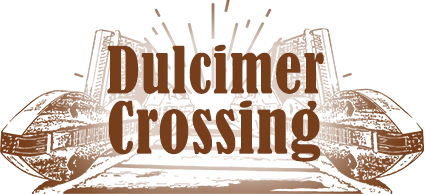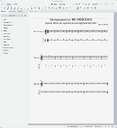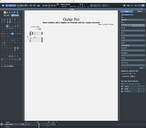Hammered Dulcimer Tablature Examples-A
First let's look at Kendra Ward Bence.
We have an example here for Battle Hymn of the Republic from her book of old time hymns, and you can see that she uses what looks like mountain dulcimer tablature.
And she's giving you 2 note harmonies, and she's using the note names.
We've got an f sharp for the lower note and an a for the upper note, and it's an a that's in a particular octave because of the little prime or apostrophe sign.
She's telling you it's not the low a, it's in the a an octave higher.
And then she she has these with no lines around them, but if you look into the 3rd measure you'll notice that the d and the e both have a line above them.
So in her system, she's got the note names to tell you where to find the notes on the instrument, but she's also letting you know that if there's no lines anywhere around the notes, you're playing in the middle.
You're playing on the right side of the treble bridge.
If there is a line that is above, like a super score, a line that's above the name of the note, you're playing on the left side of the bridge.
Likewise, in this example we don't see it, but if there was a line under the name of the note, you'd be playing that note on the bass bridge in her suggestion.
Now let's look at, this is a Linda Lyle Thompson example from her Sacred hammered dulcimer book, and, here she's doing something similar.
She's using a couple of lines in a similar way that, Kendra was.
I believe hers is actually a little older, but she's using numbers for the pitches rather than the note names so that you can learn by position, and then you can move it around if you want to.
So she's using the same thing if there is If it's in the first octave there is no prime or apostrophe.
If it moves to the second octave you have 2 apostrophes next to it or quotation mark.
So she's letting you know that in the first octave 1, 2, 3, 4, 5, 6, 7, 8, that's all that's all a one.
Or actually, I don't think she uses an 8 because she goes 1, 2, 3, 4, 5, 6, 7, and then 1 prime, and then 1 prime, 2 prime, 3 prime, 4 prime, 5 prime, 6 prime, 7 prime, and then 1 double prime, and it moves on up, and if you get into the 3rd octave, she'd use 3.
The other thing she's doing is similar to Kendra's, if there is nothing, no lines above or below the eulberg, that's telling you she's playing it on the middle, in in the middle of the instrument on the right hand side of the treble bridge.
If there's a low, if there is a bar or a line that's just below the note that's being played, it's on the bass bridge.
If there's a bar or a line above, it's on the left side of the treble bridge.
Other than that, she's using musical notation, and she's using the stems up to show you where the melody is, and the stems down to show you where accompaniment is.
So what I often do, for example, in these kinds of arrangements is I'll have my student learn all the stems up before they ever try to learn the stems down, because the stem the song can live without the stems down notes, but those notes are what make it interesting as an arrangement later.
In the tablature both are showing up all the time, so if all you read is the tablature you can't tell that.
And I always advocate that my students learn to play to both read the musical notation and the tablature if there's tablature available.
It just makes sense to have more tools in your belt if you ask me.
Now let's look at one of Maddy MacNeil's arrangements.
This is for the Lark and the Clear Air from her, Teach Yourself the Hammer Dulcimer book.
Maddie has gone with shapes rather than she's giving you note names in the way in a similar way that Kendra had in her book, but this time she's giving you with left and right designations which hammers she's suggesting you use.
And she's using a circle to delineate all those notes to the left of the treble bridge.
She's using a square or a box to be around all the notes that are in the middle or to the right of the treble bridge, and she's using a diamond shape for all the notes that are on the bass bridge.
So in this particular example, you can see that there's only one note that she has on the bass bridge at this point.
Now she's not using them every time those notes show up.
She's using it.
There's a circle on the first note, and then you're crossing over to the base to the middle of the treble bridge, and then everything else happens there until you see the diamond.
So once the the shape shows up, you're gonna stay with that shape, or you're gonna stay with that location until the shape changes.
Now obviously, there's more than one place to do this, and with each one of these arrangements you might have another way to play that you prefer.
But with the arrangement, the arranger has worked out the way it works for them and their suggestions, and if you follow those scrupulously you'll you might be able to see now why did they make those choices, and that'll help you as you're trying to work out tunes later.











0 comments
Leave a comment
Please log in or register to post a comment